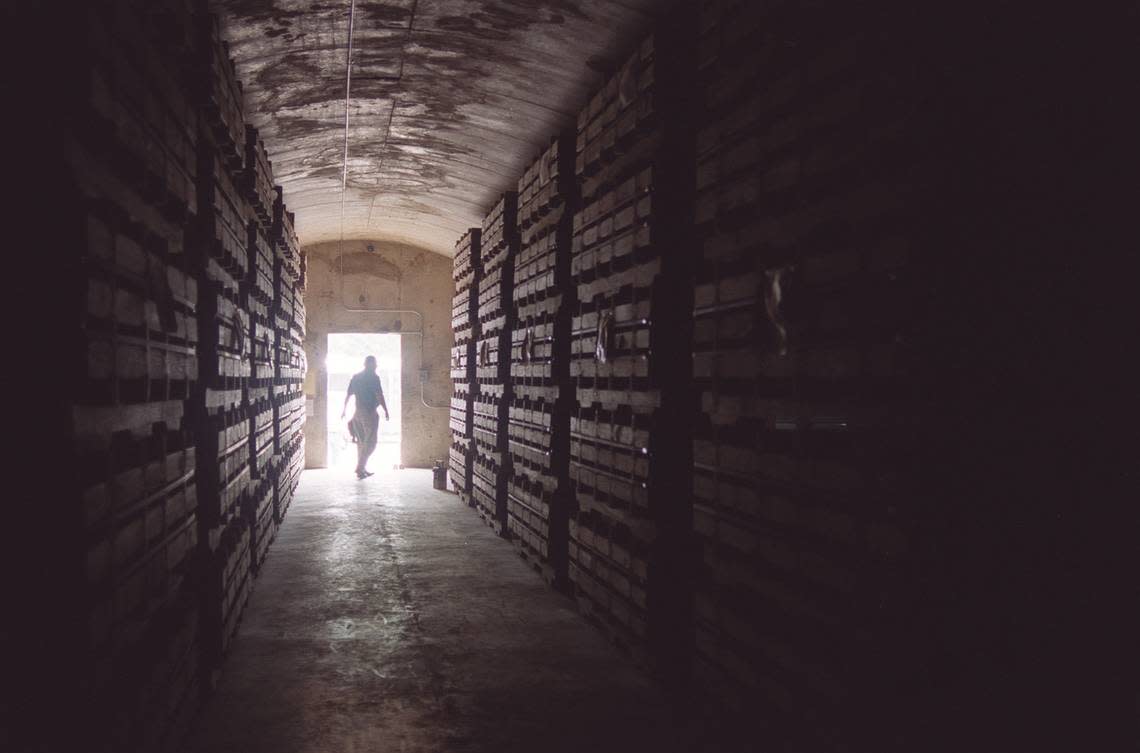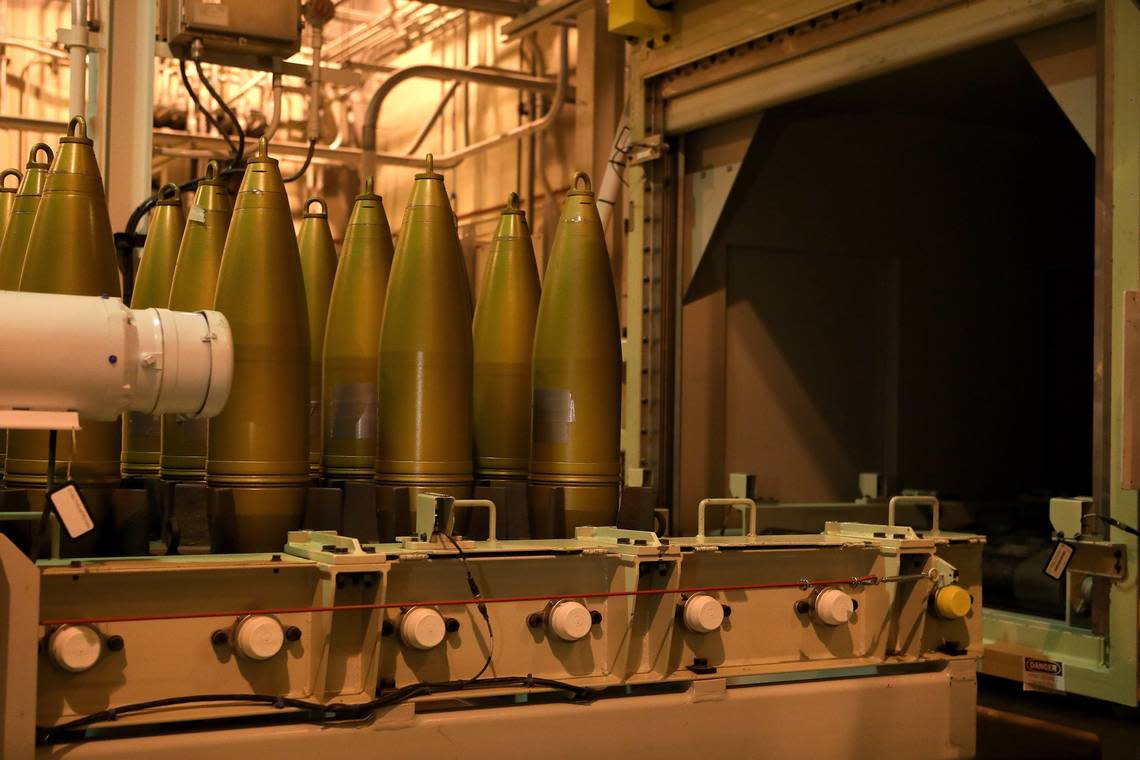Last chemical weapon in nation’s stockpile has been destroyed in Central Kentucky
The last rocket in the nation’s aging chemical weapons stockpile was destroyed Friday at the Blue Grass Army Depot in Madison County, completing a disarmament process that has been in the works for decades, the Defense Department said.
“This is a momentous day for the U.S. chemical demilitarization program,” Secretary of the Army Christine Wormuth said in a news release from the Department of Defense. “After years of design, construction, testing and operations, these obsolete weapons have been safely eliminated. The Army is proud to have played a key role in making this demilitarization possible.”
The last of the munitions at the Army Depot was an M55 rocket containing GB nerve agent, also known as sarin. The process of destroying the more than 523 tons of chemical weapons at the site, which also included VX nerve agent and mustard gas, began four years ago, in June 2019.
The effort was completed by “a joint-venture team led by Bechtel National, Inc. and Parsons Corporation, using neutralization and explosive destruction technologies to eliminate more than 100,000 mustard agent and nerve agent-filled projectiles and nerve agent-filled rockets,” the news release stated.
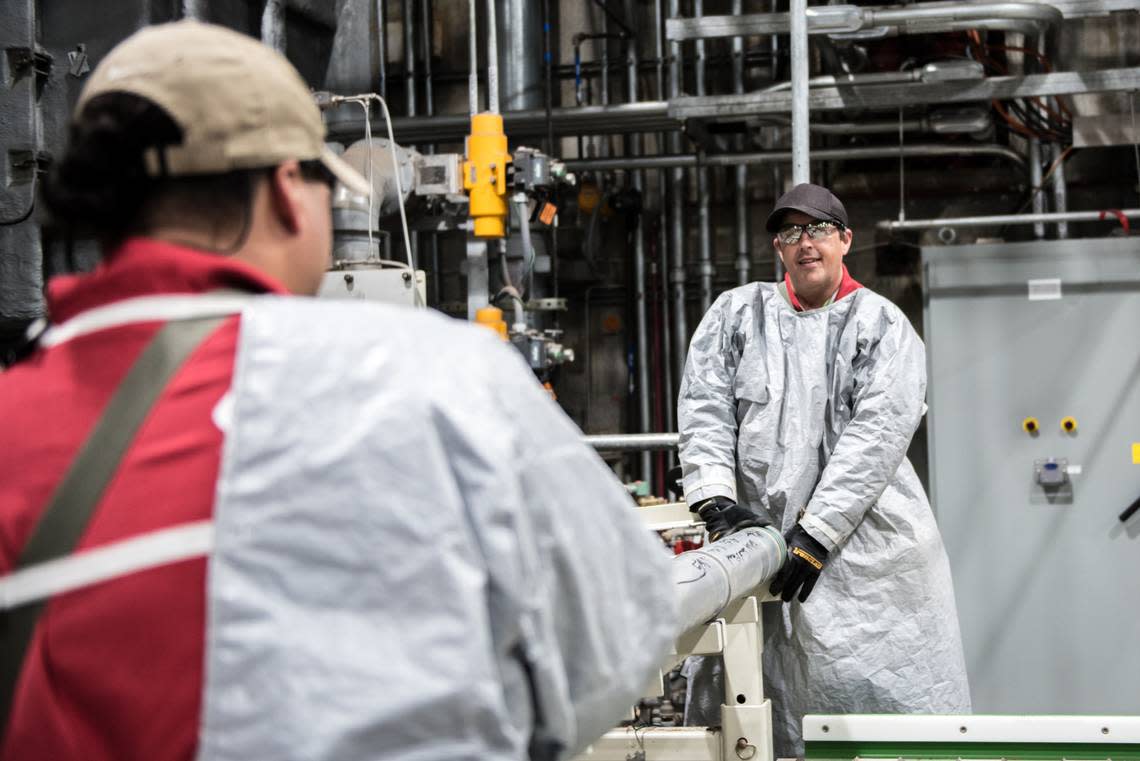
The only other U.S. facility still housing chemical weapons was the U.S. Army Pueblo Chemical Depot in Colorado. The Defense Department said that location completed its work of destroying more than 780,000 projectiles containing mustard agent June 22.
Congress mandated the destruction of the chemical weapons stockpile in 1986. That process began on Johnson Atoll in the Pacific Ocean in 1990 and was completed at other locations in Alabama, Arkansas, Indiana, Maryland, Oregon and Utah by 2012, according to the Defense Department.
The completion of the weapons disposal in Kentucky Friday marked the destruction of all stockpiles declared by the United States to the Organisation for the Prohibition of Chemical Weapons in The Hague, which oversaw the destruction of weapons under the Chemical Weapons Convention. The U.S. committed to getting rid of the stockpiles in 1997, when it signed the international arms control treaty, which “prohibits the development, production, acquisition, stockpiling, retention, transfer or use of chemical weapons by all members,” according to the Defense Department’s release.
The U.S. had committed to completing the destruction of the weapons by the end of September, and a news release from the Blue Grass Chemical Agent-Destruction Pilot Plant said the sites in Kentucky and Colorado represented “the last 10% of what was originally a national stockpile of more than 30,000 tons of chemical weapons.”
However, Madison County Judge-Executive Reagan Taylor pointed out Saturday that there is still waste at the Blue Grass Army Depot that must be dealt with, including disposing of the metal containers that held the chemical agent.
While “we hit a milestone,” he said, “the game’s not over yet.”
What’s next for the Madison County site
The process of disposing of that waste and closing the facilities where the weapons were destroyed will happen over the next three or four years, according to the Defense Department.
Michael S. Abaie, the executive officer of the Assembled Chemical Weapons Alternatives Program, said the process will include “disposal of secondary wastes, decontamination and decommissioning of facilities and equipment, disposition of property, demolition of some facilities, and close-out of contracts and environmental permits.
“During closure, the safety of the workforce, the public and the environment will remain the program’s top priority,” he said in the release.
Ron Hink, project manager for Bechtel Parsons Blue Grass, said Saturday that “we’ve got a lot of cleanup to do,” and the company, which has about 1,500 contracted employees in Madison County, will not be reducing its workforce in the immediate future.
He said it will take about a year and a half to destroy the containers that held the chemical agents, and the staff will not be impacted during that time.
Bechtel Parsons will work with community and state leaders to help find new jobs for the employees who will be displaced by the plant’s eventual closing, he said.
“We’re optimistic that we’ll find a place for everyone,” Hink said. “We go in and work our way out of a job. We’re more sensitive to the local impact.”
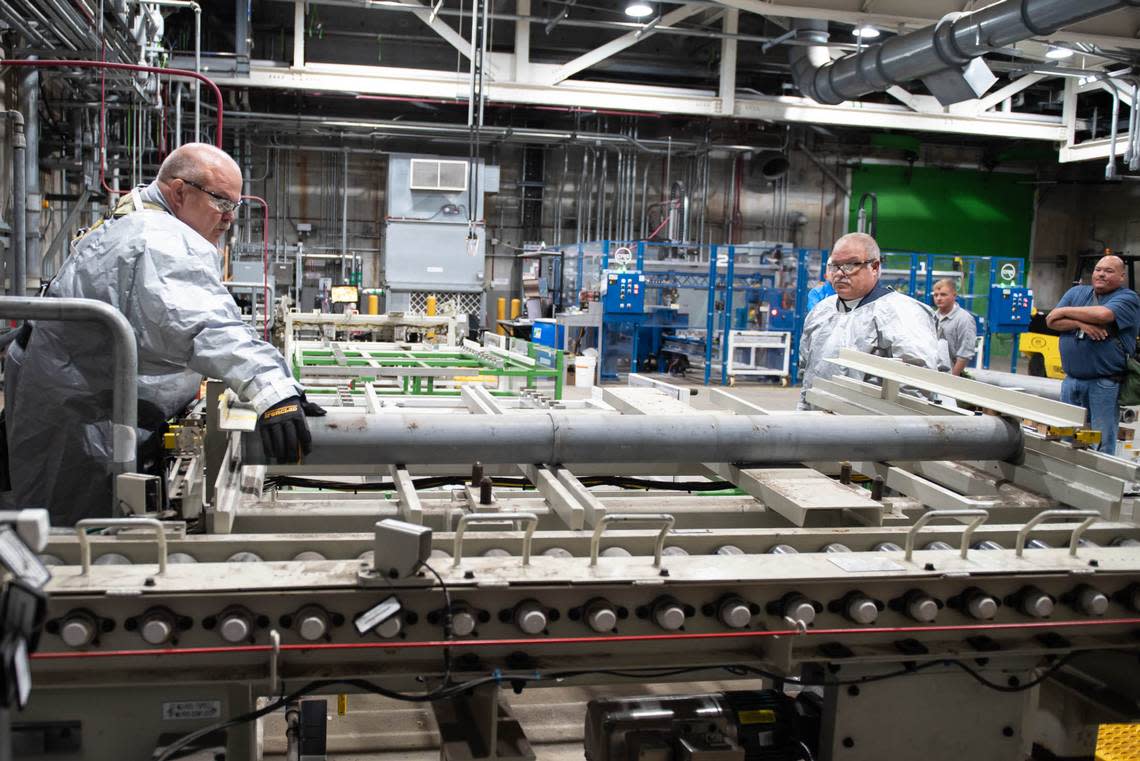
Taylor said the site provides “a big revenue stream” for the county, and he’s optimistic that jobs will be available for affected employees when the time comes.
Another concern is the future of the Chemical Stockpile Emergency Preparedness Program, which has paid for personnel, training and equipment intended to keep the community safe in the event of an emergency involving the chemical agents.
Taylor said CSEPP has “created a pretty high standard which we’re going to have to overcome” once the federal funding dries up. He said officials are preparing for that now.
“We really want this program, the CSEPP program, to leave a positive impact on our community,” he said.
The buildings where the weapons were destroyed will be decontaminated and ultimately demolished, Abaie said last month. What will happen to that part of the depot property afterward hasn’t yet been determined.
But the Blue Grass Army Depot site, comprised of nearly 14,500 acres, is used for more than chemical weapons.
William Ritter, public information officer for the Blue Grass Army Depot, said only about a quarter of what goes on at the depot involves the chemical weapons stockpile.
Of about 900 igloos on the property, only about 50 housed chemical weapons, Ritter said. The rest, he said, store “bombs, bullets and everything in the middle.”
Over the past year, he said, the depot has been busy supplying munitions the United States is providing to Ukraine and other western allies.
He said the depot also refurbishes older artillery rounds, as well as 500-pound bombs used by the Air Force.
“We do a lot of refurbishing old munitions to make old rounds basically new rounds,” which Ritter said “saves the taxpayers a huge amount of money.”
“The depot itself is not going anywhere,” he said. “There’s no end in sight.”
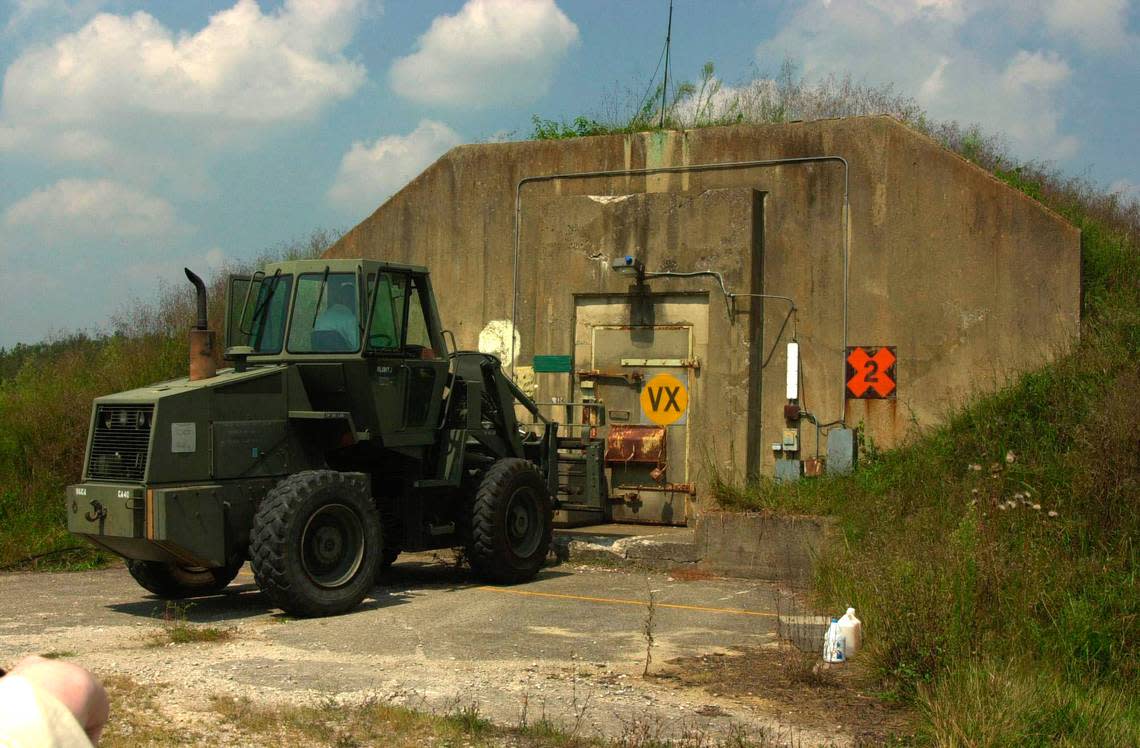
Elected officials react
Senate Republican Leader Mitch McConnell issued a statement Friday celebrating the completion of the weapons disposal, saying “Chemical weapons are responsible for some of the most horrific episodes of human loss. Though the use of these deadly agents will always be a stain on history, today our Nation has finally fulfilled our promise to rid our arsenal of this evil.”
McConnell said he had “secured nearly $7 billion in federal funding to support the responsible destruction of chemical weapon stockpiles in Kentucky and fiercely advocated on behalf of Madison County families to ensure these lethal weapons were safely eliminated from our community on our terms.”
Taylor, along with Sen. Jared Carpenter and Rep. Deanna Frazier Gordon, Republicans who represent Madison County in the state legislature, praised McConnell for his assistance with the project.
“The people of Madison County can finally breathe a sigh of relief no longer in proximity to chemical weapons,” Carpenter said in the release issued by McConnell’s office. “Their input throughout the entirety of this project has once again proven the power of grassroots advocacy. From the start, Senator McConnell has been a constant champion for our community at the federal level, and his partnership has been pivotal in ensuring a safe and transparent process.”
How the weapons were disposed of
Five types of munitions dating to as far back as the 1940s, including rockets and projectiles containing GB nerve agent, VX nerve agent and mustard agent, were disposed of at the Blue Grass Chemical Agent-Destruction Pilot Plant.
Most of the weapons were disassembled by automated equipment, and the chemical agent inside them was drained and neutralized.
The substance that remained after neutralization was pumped into holding tanks and then shipped in tanker trucks to Texas, where it was processed at Veolia Environmental Services, , according to the Assembled Chemical Weapons Alternatives Program.
After draining, the warheads that had held GB and VX nerve agents were put in temporary storage and are being destroyed in a static detonation chamber, the Assembled Chemical Weapons Alternatives Program said.
“The drained warheads that remain in storage are considered surety material, because they may contain residual chemical agent. The Chemical Stockpile Emergency Preparedness Program will continue until the surety mission is complete,” Friday’s news release stated.
Hink said the process of destroying the 50,000 warheads will take abut a year and a half.
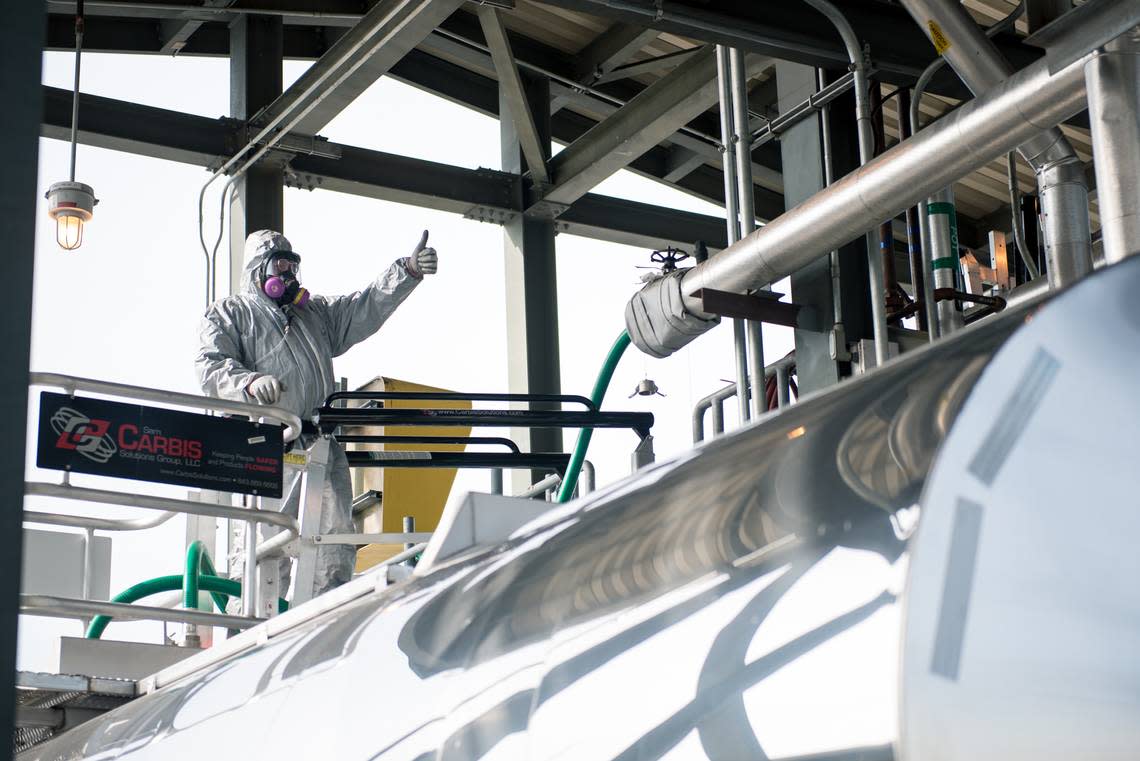
The mustard agent stockpile was destroyed in a static detonation chamber that used high temperatures to destroy the agent.
“Our constant theme throughout every munitions campaign at Blue Grass has been to safely destroy the weapons,” Hink said in a news release Friday. “Our team has safely completed every campaign, successfully completing our mission of destroying every chemical weapon stored in Kentucky.”
Environmentalist celebrates culmination of decades-long effort
For Craig Williams, the announcement that the last weapon in the stockpile has been destroyed marks the successful culmination of nearly 40 years of advocacy that he said began when “The government came in and said, ‘You have chemical weapons. We’re going to burn them. Any questions?’
“We had a lot of questions,” Williams recalled Saturday.
Williams and other community members were concerned about the Army’s plan to incinerate the weapons in Madison County, particularly in light of the proximity of the site to the population nearby.
“We could envision nerve agent wafting over the playgrounds of our kids,” said Williams, who at the time operated a cabinet business in Berea, just a few miles from the depot.
He formed the Kentucky Environmental Foundation, which began researching the hazards posed by incineration and alternative methods of disposal.
For years, he said, “the Army resisted” their efforts to dissuade the government from incinerating the chemical weapons.
Williams said the activists raised money to hire researchers and were able to show that there were other viable ways to get rid of the weapons, and they got local officials on board, which in turn helped get the attention of legislators.
They formed an international coalition and hosted a summit on chemical weapons in Richmond in 1990.
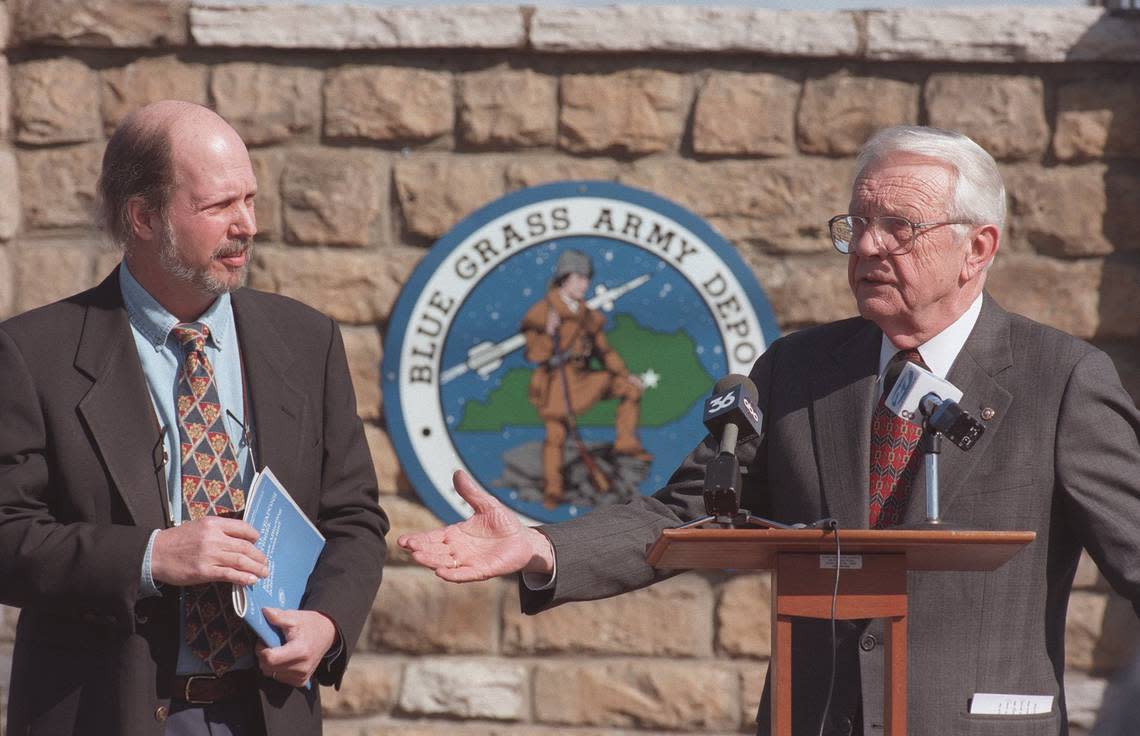
In 1996, Williams said, McConnell and Sen. Wendell Ford initiated legislation directing the Army to look at alternatives.
That, he said, was a turning point.
Since then, he said the relationship between the community, the Army and other stakeholders has “just done a complete turnaround,” and he said he hopes the result will be a model for government and community cooperation to solve problems in the future.
Central Kentucky depot is ‘very close’ to destroying chemical weapon stockpile. What’s left
